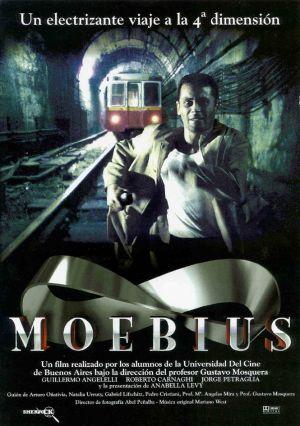 TWILIGHT ZONE fans take note: this 1997 horror/sci fi movie from Argentina is for you. Combining a compellingly offbeat story with some very potent (and disturbing) political overtones, this is an intriguing, innovative and unprecedented film that deserves a US release…which to date it hasn’t attained.
TWILIGHT ZONE fans take note: this 1997 horror/sci fi movie from Argentina is for you. Combining a compellingly offbeat story with some very potent (and disturbing) political overtones, this is an intriguing, innovative and unprecedented film that deserves a US release…which to date it hasn’t attained.
Director Gustavo Mosquera proved with his previous feature, the grim futuristic parable TIMES TO COME (LO QUE VENDRA; 1988), that he’s a talent to watch; it demonstrated a stunningly assured visual sense but was a bit thin conceptually. MOEBIUS, which ratifies the former film’s flaws with a vengeance, was made as a film school project, with the director credited as “Prof.” Gustavo Mosquera. That approach can be deadly—Brian DePalma, for instance, made HOME MOVIES (1980) with his NYU students and ended up with a near-unwatchable mess—but definitely not in this case. With MOEBIUS, Mosquera and his students managed to craft sleek and stylish visuals complimented by a tight, compelling narrative (based on the short story “A Subway Named Mobius” by A.J. Detsch…and a screenplay credited to SIX writers!).
The bad news is that this film, a definite audience pleaser (as proven by numerous successful screenings at film festivals around the world), has somehow managed to elude an American release. Those in search of evidence supporting the short sightedness of US distributors need look no further.
In the bowels of a busy subway system, a train and its forty or so passengers mysteriously vanish one morning, seemingly into thin air. The “missing” train doesn’t show up on any of its regular stops, and searches for it yield nothing. Yet it can still be heard at certain times, and the system’s intricately worked out system of tracks and signals continues to function as if the train were still running.
The system engineer is called in to check things out, but declines, instead dispatching Daniel, a mathematically minded young protégée, in his place. The inquisitive Daniel’s first stop is the home of the mysterious Dr. Mistein, who is nowhere to be found, but has the plans for the subway system’s layout stashed in his house.
Having formulated a completely outrageous solution to the problem of the missing subway train, Daniel calls a meeting with the subway’s superiors. His idea is that the subway system, with its countless add-ons over the years, has become so incredibly labyrinthine a gigantic moebius strip was unwittingly created which the missing train is now trapped on (a moebius strip can be created, FYI, by taking a strip of paper, folding it once and then joining the ends together—running along it, you’ll find yourself traversing both sides of the paper, with no end in sight). The superiors refuse to listen, opting to simply shut the system down and banish Daniel. Yet he continues his investigation, until one night when he boards a subway on his way home…and discovers, to his shock, that he’s aboard the missing train. A walk to the head of the train provides an even greater shock: the elusive Dr. Mistein is driving it…
A note on the story’s political overtones: during the seventies and early eighties over 40,000 political dissidents “vanished” from Argentina, a grievance the current administration apparently prefers to keep under wraps. It’s not difficult to see the symbolism in this film’s premise of a passenger packed subway train vanishing…or the fact that the higher-ups so thoroughly reject the hero’s studied explanation. A key line spoken near the end bears more than a passing significance: “We live in a world where nobody listens.”
Like fellow Argentine Jorge Luis Borges (whose name adorns a station seen near the end), Gustavo Mosquera takes a seemingly simple premise and invests it with a wealth of real-life significance. Over half the film takes place underground, with numerous shots of dark, dingy tunnels through which the protagonist must make his way in order to solve the mystery. The details of its unraveling, with great respect paid the fantastic, would surely make Rod Serling proud.
The lighting is superb, particularly in the contrast between the staid neon of the subway stations and the warm, inviting hews emanating from the trains themselves. In this way the trains are made to seem like chariots to Heaven, carrying their passengers away from the strife of this world, an effect completed by incredible, exhilarating POV shots zooming through subway tunnels at impossible speeds, the lights of passing stations literally streaking by. Mosquera reportedly achieved these shots himself with a personally retrofitted camera; quite an achievement, considering that he was working with an extremely limited budget and a student crew. We can only wonder what Mosquera might achieve with Hollywood-sized resources…but, based on this film’s fate thus far, it seems we’re destined to keep wondering.
Vital Statistics
MOEBIUS
Universidad Del Cine
Director/Producer: Gustavo Mosquera
Screenplay: Pedro Cristiani, Gabriel Lifschitz, Arturo Onatavia, Natalia Urruty, Maria Angeles Mira, Gustavo Mosquera
(Based on a story by A.J. Deutsch)
Cinematography: Abel Penalba
Editor: Alejandro Brodersohn, Pablo Georgelli
Cast: Guillermo Agelelli, Roberto Carnaghi, Annabella Levy, Jorge Petraglia, Miguel Angel Paludi, Fernando Llosa, Martin Adjemian, Daniel Di Biase, Jean Pierre Reguerraz, Martin Pavlovsky, Felipe Mendez, Fernando Cia, Osvaldo Santoro
